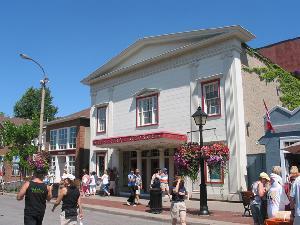 |
About the Festival.
Grab your passport and head for the border. This is not a political statement. Whether the Shaw Festival, now celebrating its fifty-fifth year in Niagara-on-the-Lake, Ontario, seriously challenges its nearby (two-hour drive) rival the Stratford Festival as the finest, or should I say my favorite, resident theatre company in North America remains a moot point after a fair number of visits over the years.
My last visit to the Shaw Festival was in 2009. Although plays by George Bernard Shaw and William Shakespeare are certainly well represented by each company during seasons that extend from April to October, their equally diverse repertories also include popular musicals, classic and contemporary plays from a wide array of world class playwrights.
Both theatres have large resident companies, with many of the performers appearing in more than one show. An actor in a leading role at a matinee can often be spotted in a supporting role in the evening. Actors who appear one season at Stratford may sometimes be seen at Shaw in another. What fun for them and for the audience.
Worth mentioning is the informative program handed out for each show with both the director's notes and the production's history. Pre-show discussions with members of the company are as popular as are the post show Q & A.
While a split week attending both Festivals is ideal for visitors to Ontario and considering I devoted a full week last time to Stratford, I decided to see eight shows over four days at the Shaw Festival beginning Tuesday August 1. As the Shaw produces ten shows each season, I missed just two.
This year Canada is celebrating its 150th anniversary and the Shaw is enjoying its first season under the guidance of its new artistic director Tim Carroll. Former Artistic Director Jackie Maxwell since 2002 has been honored with having one of the Festival's four theaters named for her.
With the wondrous Niagara Falls and numerous wineries only minutes away, I was once again awed by the charm of this former garrison town. Glorious flowers and lush plants line the entire length of Queen's Parade the main thoroughfare and where all four of the Festival's theaters can be found amidst many fine restaurants, boutiques and, of course, the famous Cows Ice Cream parlor. A beautiful and large park with a wading pond for children and the historic Prince of Wales Hotel are other welcoming destination points on this route. The best thing is that every destination is an easy, safe and picturesque walk.
Less inclined to stay at a fancy hotel than at a B&B, I returned for the third time to Anne's Open Door where our hosts Janice and George Schachtschnieder continue to take great care of their guests and provide a hearty breakfast. If you are coming a distance, it is advisable to arrive the day or evening before you begin binging on double headers. As luck would have it, we had blue skies every day....that is until our last night just before curtain time when the skies suddenly turned dark, the wind began to whistle through swaying trees, the rain came down in buckets and a tornado alert was sounded. The show that night was Dracula . No fooling. The next morning the sun shone as we headed back to the USA.
|
Me and My Girl (through Oct. 15 at the Festival Theatre). This endearingly corny 1930s hit was successfully revived in London and soon after in New York in 1986 where it was the inaugural show at the then new Marquis Theatre. There, it enjoyed a run of three years with its British star Robert Lindsay getting a Tony for his performance. Revisiting this show thirty-one years later was a treat. Whatever revisions for modern audiences (but, what's with the references to My Fair Lady ?) were made to the original book by Stephen Fry and Mike Ockrent for modern audiences may be inconsequential, but not so the lilting melodic score by Noel Gay. The show's most familiar song "The Lambeth Walk" became the rage in London at the time. It continues to encourage an audience to sway and clap in rhythm as the performers take to the aisles.
Under the spirited direction of Ashlie Corcoran the company has a grand time cavorting through the nonsensical plot in which a poor cockney bloke (Michael Therriault) is suddenly catapulted into money and Earldom but refuses to leave behind his lady love (Kristi Frank.) If director Corcoran has encouraged/endorsed the terrifically talented Therriault to mug a little too much and deploy too much clownishness into his antics a la Danny Kaye, the audience adores him. Parker Esse's choreography harks back nostalgically to the everybody-come-out-and-tap-your-heart-out era while Sue LePage's stunning costumes and Drew Facey's classy unit setting dressed up a by-gone era with by-golly creativity.
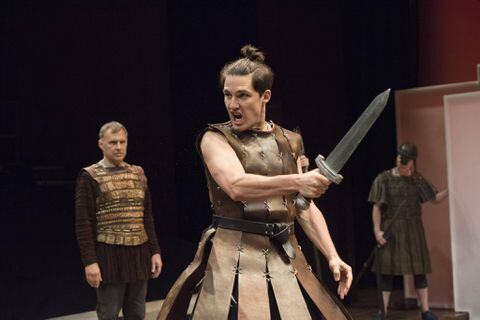
Jeff Irving, Jay Turney, Jenny L. Wright photo credit: David Cooper
Androcles and the Lion.(through October 7) The plays of George Bernard Shaw are arguably as
intellectually challenging as they are dramatically long-winded. But
this one written in 1912, as directed by the Festival's new artistic
director Tim Carroll, puts this witty exercise in Christian morality vs
pagan demagoguery into an extraordinarily playful arena. During its
progress, audience members become co-contributors with the actors as
their own stories of become mixed into Shaw's verbose text. The feeling
of a parlor game is created from the beginning with the breakdown of the
fourth wall as actors leave the stage and enter at first as themselves
asking for a volunteer to read from the script and someone to play the
Lion.

Wild Tales (through October 7). In case you have forgotten, Oscar Wilde wrote short stories as well as plays. This is another clever and entertaining show geared for children and it has an 11 am curtain. It also runs for just one hour giving grown-ups time for lunch before any of the 2 pm matinees. A half dozen youngsters have been pre-selected to participate minimally in this amusing diversion that incorporates four parable like stories as adapted for the stage by Kate Henning. The Selfish Giant , about the saving grace of children; The Nightingale and the Rose , and The Happy Prince , about sacrifice and salvation are sandwiched within The Remarkable Rocket about a frustrated firecracker rocket who is kept earthbound by his ego.
Kudos to director Christine Brubaker for creating a simple playground. The actors are dressed in the whimsical costumes and perform within the single setting — basically the giant's garden — designed by Jennifer Goodman. They work a lot with puppets. Whether every child will ponder the deeply spiritual lessons of the stories is questionable, but that is where those who accompany them can take over. The children at the performance I attended loved every minute.
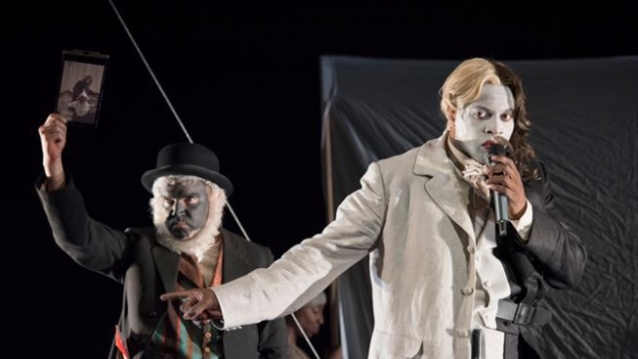 An Octoroon>
(through October 14). Here's hoping you can last through the first
scene of playwright Branden Jacobs-Jenkins purposely inflammatory and
certainly challenging play. In the opening scene, one black man and one
white man standing in their undershorts yell f..k you back and forth for
longer than most scenes in a David Mamet play. If you can take it, you
will be demonstrating more pluck than many did on the night I attended.
And that was nothing compared to the even larger exodus at intermission
leaving those who remained to see to a play clearly intended provoke and
reopen racial wounds. As unflinchingly directed by Peter Hinton, this
uneasily digested comedy is culled from the fasten-your-seat-belts-
it's-going-to-be-a-bumpy-evening school of theater.
An Octoroon>
(through October 14). Here's hoping you can last through the first
scene of playwright Branden Jacobs-Jenkins purposely inflammatory and
certainly challenging play. In the opening scene, one black man and one
white man standing in their undershorts yell f..k you back and forth for
longer than most scenes in a David Mamet play. If you can take it, you
will be demonstrating more pluck than many did on the night I attended.
And that was nothing compared to the even larger exodus at intermission
leaving those who remained to see to a play clearly intended provoke and
reopen racial wounds. As unflinchingly directed by Peter Hinton, this
uneasily digested comedy is culled from the fasten-your-seat-belts-
it's-going-to-be-a-bumpy-evening school of theater. Racism is ugly and it peaks again and again with comical and an occasionally horrifying intensity throughout this play, a dramatic expansion/adaptation of Dion Boucicault's 1859 play The Octoroon . A black actor in white face, a white actor in red face as an American Indian amidst an overall mocking of color-blind casting give an added edge to this over-the-top melodrama, a hit in its time. At the center is a terrific performance by Andre Sills, who plays three roles, including playwright Jacobs-Jenkins. As George the heir to a plantation, he woos Zoe the titular Octoroon (Vanessa Sears). Being one-eighth black and the daughter of his Uncle, she is forever fighting off the attentions of the play's leering villain (also Sills) who is scheming to buy the plantation. Murder, mayhem and mischief naturally ensue. A fine supporting cast portray absurdly stereotypical characters in a raw play that doesn't hold back its message or its vision of where we were not so long ago.

Now that we are all getting used to color-blind casting and women playing men, be comforted that our George is played superbly by Tom McCamus, Not sure how much of a pleasure it is to watch him in action as his sanity deteriorates, but his stamina is notable. There isn't much of a story here unless you care about the predictable plotting and obligatory political intrigue that keeps twelve actors busy changing wigs and costumes playing multiple roles. Having just seen Andre Sills careen through An Octoroon , it was nice to see him more stately as Prime Minister William Pitt. The rest of the supporting cast make too much of courtly affectations bordering on camp. McCamus gives another standout performance in St. Joan . Spotting the players in other plays is part of the joy at Shaw.
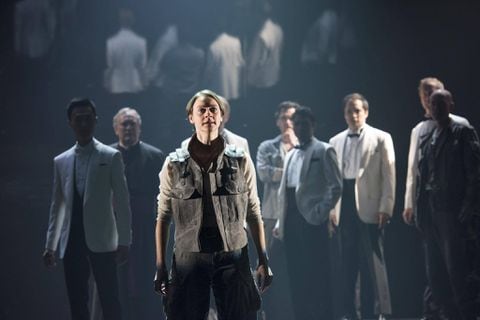
Sara Topham as St. Joan and company photo credit: David Cooper
St. Joan (through October 5). Shaw's 1923 play, about Joan of Arc, the young girl who heard voices of angels in the 15th century and guided the French army to drive the English out of France, is usually as good as the director who can guide the actor in the titular role through a great performance. In his first production for Shaw, Tim Carroll is the splendid director and Sara Topham is the wonderful Joan. A highlight is the production's post cubism monolithic designs by Judith Bowden enhanced by Kevin Lamotte other-worldly lighting design. The abstractionism works beautifully for the play's longish discourses between the sacred and the profane.
Of all Shaw's plays, this is the one that doesn't cry out as Joan must, "How long, oh Lord, how long" although at nearly three hours (cut from the original four-hour text), we still get the future saint's message loud and clear. What is loudest and clearest are Joan's empowering convictions, and all the wordy confrontations between the persecutors and prosecutors. All of them spoken impressively and never merely recited by a supporting company that manage to appear and disappear almost by magic. It was great to our George III (Tom McCamus) again on stage this time as the crafty Warwick. But it remains for Topham's unsentimentally modernist Joan keep us in the thrall of her un
wavering belief. She does and we are.
Another significant occasion is the sporadic visit of Christina's travelling salesman lover Gerry (Kristopher Bowman) who is full of dreams in an otherwise empty reality. The most practical sister Kate Fiona Byrne) keeps the minimally employed sisters, as gingerly played by Claire Jullien, Diana Donnelly and Tara Rosling, in line adhering to their Catholic faith and committed to their domestic obligations. Under Krista Jackson's direction, the actors reveal the credibly evolving aspects of their characters, none more engaging than Patrick Galligan as the older monologue-driven Michael. If Sue Lepage's setting is not as evocative as it might be, it otherwise frames the words of a playwright who knows how to create a time and place.

The spare setting designed by Michael Gianfrancesco is artfully designed, with various locations created with movable curtained partitions like those in hospital rooms and moved about by the characters. The superior special effects can be credited to Alan Brodie's atmospheric lighting design and Cameron Davis eerie projections. What I liked best about this overly talky, almost three hours, and psychologically expository version is the visitations of Dracula's undead brides who swarm around the castle in their loose negligees looking for a night time nibble. The acting by the principles is first-rate. Physically imposing Allan Louis would have been more chilling as Dracula if he had spent a little more time on stage and particularly on the necks of Mina (Marla McLean) and her cousin Lucy (Cherissa Richards.) Graeme Somerville provides the most shivers as the demented Renfield. What could have been a supernatural feast, however, turned out to be an only occasionally sexually titillating tasting.
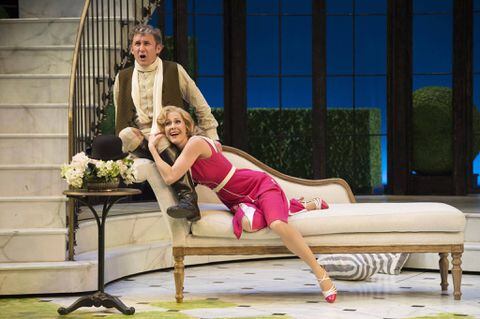

No comments:
Post a Comment